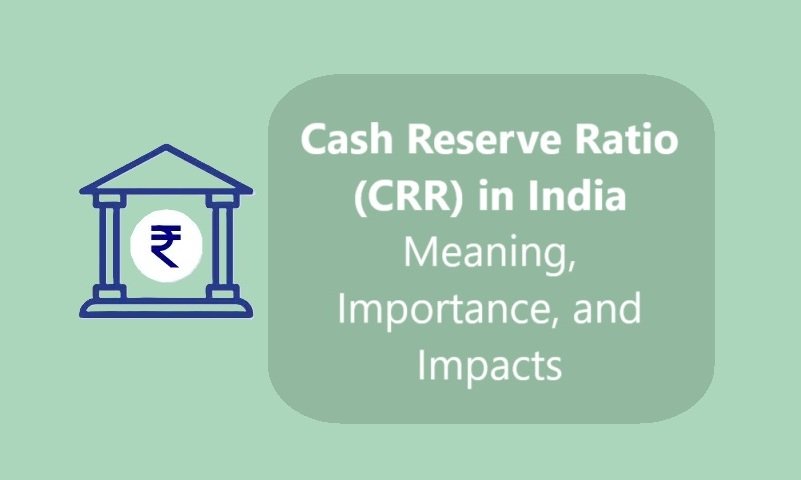
What is the Cash Reserve Ratio (CRR)?
The Cash Reserve Ratio (CRR) is a monetary policy tool used by the Reserve Bank of India (RBI) to regulate the liquidity and money supply in the Indian economy. It refers to the percentage of a commercial bank’s net demand and time liabilities (NDTL) that must be maintained as reserves with the RBI. These reserves are held in cash and cannot be used for lending or investment purposes by the banks.
The primary objective of CRR is to ensure liquidity control, stabilize inflation, and safeguard depositor interests by ensuring banks maintain a minimum reserve.
Current Legal Framework
CRR is governed under Section 42 of the Reserve Bank of India Act, 1934. The RBI periodically reviews and determines the CRR percentage, depending on the economic conditions and monetary policy requirements.
How is CRR Calculated?
CRR is expressed as a percentage of a bank’s Net Demand and Time Liabilities (NDTL).

Where:
- Net Demand Liabilities: Include current accounts, savings accounts, and fixed deposit balances of the public.
- Time Liabilities: Include deposits with fixed maturity periods.
For example, if a bank’s NDTL is ₹1,00,000 crore and the CRR is 4%, the bank must maintain ₹4,000 crore as reserves with the RBI.
Objectives of CRR
- Control Inflation: By adjusting CRR, the RBI can reduce or increase the money supply in the economy, helping to manage inflation.
- Liquidity Management: Ensures that banks maintain enough reserves to meet depositor withdrawals and other liabilities.
- Monetary Policy Implementation: Serves as a direct tool for the RBI to regulate liquidity in the banking system.
- Financial Stability: Reduces the risk of over-lending by banks and prevents financial crises.
Importance of CRR
- Control of Money Supply
CRR directly impacts the funds available with banks for lending. A higher CRR reduces the money supply, while a lower CRR increases liquidity. - Inflation Control
During periods of high inflation, the RBI may raise the CRR to reduce excess liquidity, thereby curbing spending and price increases. - Banking System Safety
By mandating that a portion of deposits be kept as reserves, CRR ensures banks have adequate liquidity to meet withdrawal demands and avoid insolvency risks. - Economic Growth
When the RBI lowers the CRR, banks have more funds to lend, which stimulates economic growth by encouraging investments and consumption.
CRR in Practice
High CRR
- A high CRR means banks must keep a larger portion of their deposits with the RBI, reducing their ability to lend.
- Impact: Decreases money supply, controls inflation, and tightens liquidity.
Low CRR
- A low CRR allows banks to lend more, increasing money supply in the economy.
- Impact: Encourages economic growth but can lead to inflation if not monitored.
Advantages of CRR
- Effective Liquidity Control
CRR allows the RBI to directly influence the liquidity in the banking system without printing or destroying currency. - Inflation Management
It helps in stabilizing inflation by controlling excess money supply in the economy. - Banking Sector Discipline
Encourages financial discipline among banks by ensuring they maintain adequate reserves. - Safe Depositor Funds
By mandating reserves, CRR protects depositors’ money and minimizes the risk of bank failures.
Disadvantages of CRR
- Reduced Lending Capacity
A higher CRR reduces the funds available for banks to lend, which may impact their profitability and growth. - Economic Slowdown
During tight monetary policies, high CRR may result in reduced credit availability, hampering economic activity. - No Interest on Reserves
Banks do not earn any interest on the funds maintained as CRR, leading to an opportunity cost. - Dependence on Monetary Policy
Frequent changes in CRR can create uncertainty in the banking sector and affect long-term planning.
CRR vs. Other Monetary Tools
- Statutory Liquidity Ratio (SLR): SLR is the percentage of NDTL that banks must maintain in the form of liquid assets like gold or government securities, while CRR is maintained as cash with the RBI.
- Repo Rate: The interest rate at which the RBI lends funds to banks. Unlike CRR, it involves borrowing and lending transactions.
- Open Market Operations (OMO): The RBI buys or sells government securities in the market to influence liquidity, whereas CRR involves no direct market transactions.
Examples of CRR’s Impact in India
- During High Inflation
In 2010, to curb rising inflation, the RBI increased the CRR to 6%, which reduced liquidity in the market, thereby controlling inflationary pressures. - During Economic Slowdown
In response to the COVID-19 pandemic in 2020, the RBI reduced CRR from 4% to 3%, releasing additional funds into the banking system to support lending and economic recovery.
CRR Trends in India
Historically, the CRR in India has varied based on economic conditions:
- It was as high as 15% in the early 1990s.
- Over the years, the RBI has gradually reduced it to promote lending and economic growth.
- As of now, the CRR is at 4.5% (subject to periodic revision by the RBI).
Conclusion
The Cash Reserve Ratio (CRR) is a crucial monetary policy tool that enables the Reserve Bank of India to regulate liquidity, stabilize inflation, and maintain financial stability. While it imposes certain limitations on banks’ lending capacity, its role in ensuring a safe and balanced banking system cannot be overstated.
For a growing economy like India, maintaining the right balance of CRR is vital to achieving sustainable growth while keeping inflation under control. Understanding CRR and its implications can provide valuable insights for businesses, investors, and policymakers alike.






